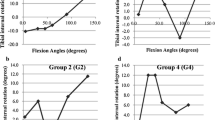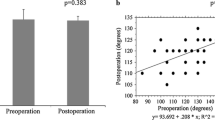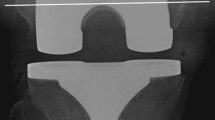Abstract
Purpose
To investigate the factors affecting intraoperative kinematics, as measured with a navigation system, and their effect on maximum flexion angles during total knee arthroplasty (TKA).
Method
One hundred posterior stabilised (PS) TKAs performed using an image-free navigation system were evaluated. Tibial internal rotation angles at maximum extension, 30°, 45°, 60°, 90°, and maximum flexion were collected at registration and after implantation. The varus angles from the coronal mechanical axis were also collected. The rotational patterns were divided into four groups to investigate whether flexion contracture and varus deformity affected the kinematic patterns, and correlated with the maximum pre- and post-operative flexion angles.
Results
At registration, the flexion angles at maximum extension differed significantly between the kinematic groups; the flexion angle at maximum extension at registration was negatively correlated with the pre-operative maximum flexion angle (R 2 = 0.226, p < 0.0001) and the post-operative maximum flexion angle (R 2 = 0.059, p = 0.0167). Varus deformity at registration also differed significantly between the kinematic groups; varus deformity at registration was negatively correlated with the pre-operative maximum flexion angle (R 2 = 0.087, p = 0.0036) and post-operative maximum flexion angle (R 2 = 0.101, p = 0.0027).
Conclusion
Navigation-based measurements in patients undergoing PS TKA indicated that pre-operative flexion contracture and varus deformity are negatively correlated with both pre- and post-operative maximum flexion angles. The results may improve the ease with which surgeons can interpret intraoperative kinematics, by providing a multi-dimensional perspective. With further knowledge regarding intraoperative kinematics, it might be possible to improve surgical approach, prosthesis design, and clinical outcomes.
Level of evidence
II.




Similar content being viewed by others
References
Akagi M, Mori S, Nishimura S, Nishimura A, Asano T, Hamanishi C (2005) Variability of extraarticular tibial rotation references for total knee arthroplasty. Clin Orthop Relat Res 436:172–176
Cavaignac E, Carpentier K, Pailhe R, Luyckx T, Bellemans J (2014) The role of the deep medial collateral ligament in controlling rotational stability of the knee. Knee Surg Sports Traumatol Arthrosc. doi:10.1007/s00167-014-3095-1
Chinzei N, Ishida K, Matsumoto T, Kuroda Y, Kitagawa A, Kuroda R, Akisue T, Nishida K, Kurosaka M, Tsumura N (2014) Evaluation of patellofemoral joint in ADVANCE Medial-pivot total knee arthroplasty. Int Orthop 38(3):509–515
Cromie MJ, Siston RA, Giori NJ, Delp SL (2008) Posterior cruciate ligament removal contributes to abnormal knee motion during posterior stabilized total knee arthroplasty. J Orthop Res 26(11):1494–1499
Dennis DA, Komistek RD, Hoff WA, Gabriel SM (1996) In vivo knee kinematics derived using an inverse perspective technique. Clin Orthop Relat Res 331:107–117
Dennis DA, Komistek RD, Mahfouz MR, Walker SA, Tucker A (2004) A multicenter analysis of axial femorotibial rotation after total knee arthroplasty. Clin Orthop Relat Res 428:180–189
Goudie ST, Deakin AH, Ahmad A, Maheshwari R, Picard F (2011) Flexion contracture following primary total knee arthroplasty: risk factors and outcomes. Orthopedics 34(12):e855–e859
Harvey IA, Barry K, Kirby SP, Johnson R, Elloy MA (1993) Factors affecting the range of movement of total knee arthroplasty. J Bone Joint Surg Br 75(6):950–955
Ho FY, Ma HM, Liau JJ, Yeh CR, Huang CH (2007) Mobile-bearing knees reduce rotational asymmetric wear. Clin Orthop Relat Res 462:143–149
Ishida K, Shibanuma N, Matsumoto T, Sasaki H, Takayama K, Matsuzaki T, Tei K, Kuroda R, Kurosaka M (2014) Navigation-based femorotibial rotation pattern correlated with flexion angle after total knee arthroplasty. Knee Surg Sports Traumatol Arthrosc. doi:10.1007/s00167-014-3340-7
Kitagawa A, Ishida K, Chin T, Tsumura N, Iguchi T (2014) Partial restoration of knee kinematics in severe valgus deformity using the medial-pivot total knee arthroplasty. Knee Surg Sports Traumatol Arthrosc 22(7):1599–1606
Klein GR, Parvizi J, Rapuri VR, Austin MS, Hozack WJ (2004) The effect of tibial polyethylene insert design on range of motion: evaluation of in vivo knee kinematics by a computerized navigation system during total knee arthroplasty. J Arthroplasty 19(8):986–991
Komistek RD, Dennis DA, Mahfouz M (2003) In vivo fluoroscopic analysis of the normal human knee. Clin Orthop Relat Res 410:69–81
Matsuda S, Kawahara S, Okazaki K, Tashiro Y, Iwamoto Y (2013) Postoperative alignment and ROM affect patient satisfaction after TKA. Clin Orthop Relat Res 471(1):127–133
Matsuzaki T, Matsumoto T, Kubo S, Muratsu H, Matsushita T, Kawakami Y, Ishida K, Oka S, Kuroda R, Kurosaka M (2014) Tibial internal rotation is affected by lateral laxity in cruciate-retaining total knee arthroplasty: an intraoperative kinematic study using a navigation system and offset-type tensor. Knee Surg Sports Traumatol Arthrosc 22(3):615–620
Matsuzaki T, Matsumoto T, Muratsu H, Kubo S, Matsushita T, Kawakami Y, Ishida K, Oka S, Kuroda R, Kurosaka M (2013) Kinematic factors affecting postoperative knee flexion after cruciate-retaining total knee arthroplasty. Int Orthop 37(5):803–808
Mochizuki T, Sato T, Blaha JD, Tanifuji O, Kobayashi K, Yamagiwa H, Watanabe S, Matsueda M, Koga Y, Omori G, Endo N (2014) Kinematics of the knee after unicompartmental arthroplasty is not the same as normal and is similar to the kinematics of the knee with osteoarthritis. Knee Surg Sports Traumatol Arthrosc 22(8):1911–1917
Mochizuki T, Sato T, Tanifuji O, Kobayashi K, Koga Y, Yamagiwa H, Omori G, Endo N (2013) In vivo pre- and postoperative three-dimensional knee kinematics in unicompartmental knee arthroplasty. J Orthop Sci 18(1):54–60
Moschella D, Blasi A, Leardini A, Ensini A, Catani F (2006) Wear patterns on tibial plateau from varus osteoarthritic knees. Clin Biomech (Bristol, Avon) 21(2):152–158
Ngai V, Wimmer MA (2009) Kinematic evaluation of cruciate-retaining total knee replacement patients during level walking: a comparison with the displacement-controlled ISO standard. J Biomech 42(14):2363–2368
Nishio Y, Onodera T, Kasahara Y, Takahashi D, Iwasaki N, Majima T (2014) Intraoperative medial pivot affects deep knee flexion angle and patient-reported outcomes after total knee arthroplasty. J Arthroplasty 29(4):702–706
Ritter MA, Harty LD, Davis KE, Meding JB, Berend ME (2003) Predicting range of motion after total knee arthroplasty. Clustering, log-linear regression, and regression tree analysis. J Bone Joint Surg Am 85(7):1278–1285
Schurman DJ, Matityahu A, Goodman SB, Maloney W, Woolson S, Shi H, Bloch DA (1998) Prediction of postoperative knee flexion in Insall-Burstein II total knee arthroplasty. Clin Orthop Relat Res 353:175–184
Tei K, Ishida K, Matsumoto T, Kubo S, Sasaki H, Shibanuma N, Akisue T, Nishida K, Kurosaka M, Kuroda R (2012) Novel image-matching software for postoperative evaluation after TKA. Orthopedics 35(12):e1711–e1715
Yoon JR, Oh KJ, Wang JH, Yang JH (2014) Does patella position influence ligament balancing in total knee arthroplasty? Knee Surg Sports Traumatol Arthrosc. doi:10.1007/s00167-014-2879-7
Author information
Authors and Affiliations
Corresponding author
Rights and permissions
About this article
Cite this article
Ishida, K., Shibanuma, N., Matsumoto, T. et al. Factors affecting intraoperative kinematic patterns and flexion angles in navigated total knee arthroplasty. Knee Surg Sports Traumatol Arthrosc 23, 1741–1747 (2015). https://doi.org/10.1007/s00167-015-3572-1
Received:
Accepted:
Published:
Issue Date:
DOI: https://doi.org/10.1007/s00167-015-3572-1




